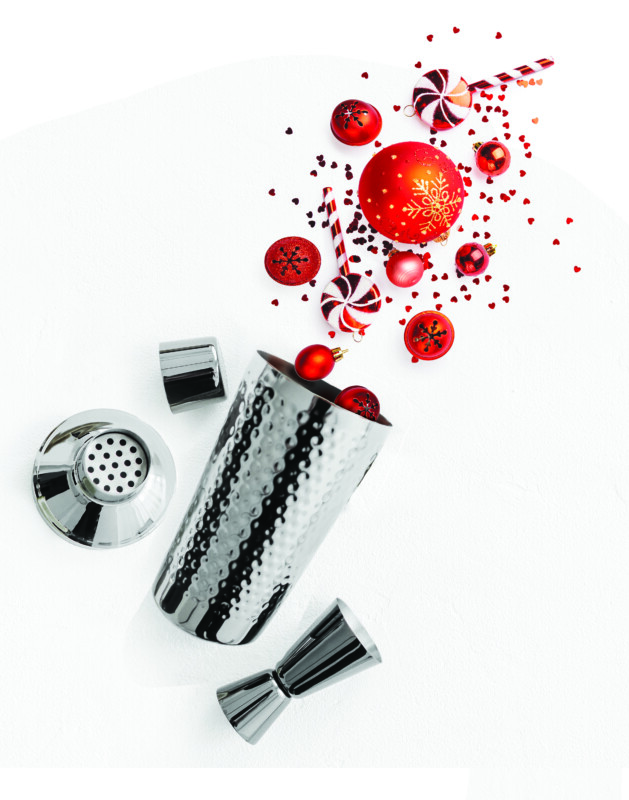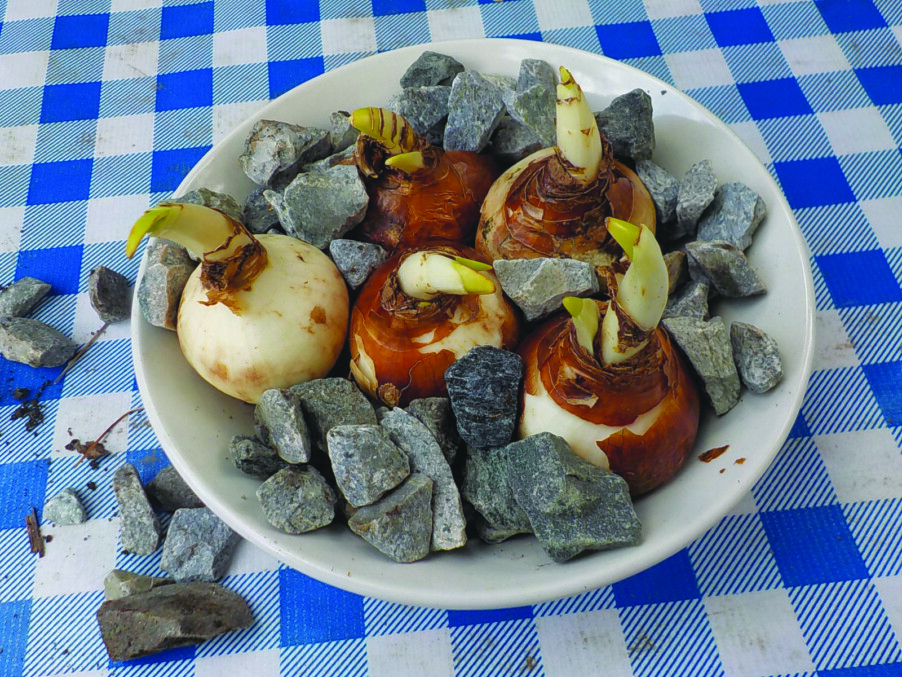Wherein John Fladd presents “TannenBombed – A High-Proof Christmas Card in Eight Parts.”
A note on measurements: For non-liquid ingredients, like sugar and stuff, I measure by volume and weigh it as I go. In general when I cook, I almost entirely measure ingredients by weight, when possible, especially with baking, because I find it’s more precise. For those who prefer to wing it with cups and teaspoons, I’ve approximated those.
Part 1:
Saint Nicholas
A lot of people conflate Saint Nicholas with Santa Claus, which is, at best, overly simplistic and, at worst, potentially dangerous. He was not a man to take lightly.
Nicholas of Myrna is one of the early Catholic and Orthodox saints — really early, like Roman Empire-early. Apparently, “jolly” was not really one of his outstanding character traits. Nicholas was more of a roll-up-the-sleeves-of-your-robes-and-knock-some-sense-into-them kind of saint. According to the Saint Nicholas Center (stnicholascenter.org), during his lifetime he was best known for chasing demons out of trees with an ax — apparently demonic possession of trees was a thing in the fourth century — and punching a fellow theologian in the face at the Council of Nicaea.
“But, surely,” you say, “he must have had something to do with children. He’s the Patron Saint of Children, after all.”
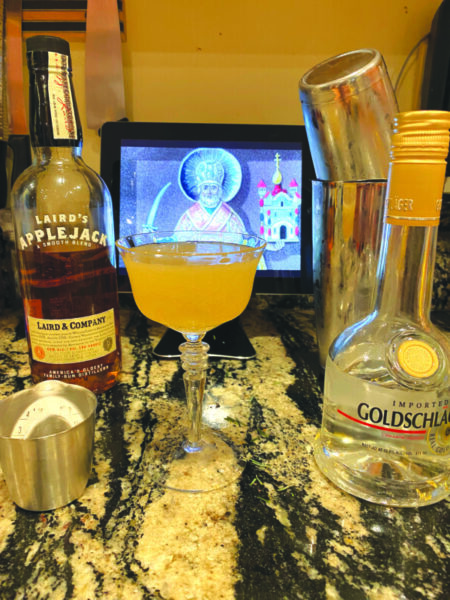
Funny you should ask, actually. Yes, Saint Nicholas is the Patron Saint of Children — as well as thieves, brewers, sailors and wolves — because of a light, charming, amusing* anecdote. (*Actually, it’s pretty much the opposite of light or charming.)
It seems that a rogue butcher, or maybe an innkeeper – there are several versions of the story — kidnapped three children and cut them up to make into sausage. Worried parents asked Nicholas to get their children back for them. According to the story, Nicholas went to the butcher’s workshop and called for the children to come home with him, whereupon the body parts sprang up from various vats, reassembled themselves into little boys and followed him back to their village. The moral of the story, I suppose, is that even in the Late Roman Empire some things were off the table — literally, in this case.
A more cheerful story — and probably the connection with Santa Claus — is the story of The Golden Balls:
It seems that a wealthy man fell on hard times and didn’t have any money to provide his three daughters with dowries to attract good husbands. He was in the process of preparing to sell them into prostitution — because of course he was — when Nicholas saved the day by throwing three gold balls down their chimney, where they landed in the girls’ shoes, or possibly their stockings.
You would think that this would be enough to make him the Patron Saint of Brides or Stockings or maybe Balls, but in fact it landed him the gig as Patron Saint of Pawn-Brokers. (This is why most pawn shops have a sign with three golden balls by their front doors.)
Pawnbroker Cocktail
- 2 ounces apple brandy — I like Laird’s Applejack
- 1 ounce Goldschläger — a cinnamon schnapps with flecks of actual gold in it
- 1 ounce fresh-squeezed lemon juice
Combine all ingredients with ice in a cocktail shaker.
Shake.
Strain into a small, fancy glass. As you drink this, think about how much you’d have to pay someone to take one of your kids off your hands. You’ll come away with a new appreciation for Nicholas.
This is a take on a classic cocktail called a sidecar. Think of it as a cousin to a margarita, but with brandy instead of tequila, and, in this case, a sweet, cinnamony associate. The taste of this drink is very cinnamon-forward, but, as with Saint Nicholas himself, do not underestimate it. The Goldschläger is sweet and a bit candy-like but clocks in at over 80 proof. If you had too many of these too quickly, you could find yourself threatening your houseplants with a spatula, trying to rid them of malignant spirits. (In fact, you are probably just over-watering them.)
Part 2:
Drinking punch with Charles Dickens
Charles Dickens was a big fan of punch — proper punch, with something sweet, something sour, and an alcoholic kick that would stun a musk ox. During the Victorian period, being able to serve a self-respecting punch was a status symbol for any host. Today we think of the term “punch drunk” in the sense of a boxer who is on his last legs, but the whole reason that phrase ever caught on in the first place is that everyone was familiar with the concept of being drunk on punch.
Apparently, Dickens’ favorite punch was a version of something called a Smoking Bishop, which was traditionally heated by lighting it on fire or, better yet, plunging a red-hot poker into it, which frankly seems a bit intimidating. Fortunately he provided an alternative.
In A Christmas Carol Dickens makes several passing references to punch but never gets specific about what, aside from lemons, should go into a decent Christmas punch. (The lemons themselves are a bit of a tell, though. When you think of what an extravagance lemons would have been to a man like Bob Cratchit, you get a glimpse into what a special occasion punch-drinking was.) A better guide comes from Our Mutual Friend:
‘You don’t use lemon in your business, do you?’ asked Wegg, sniffing again.
‘No, Mr Wegg,’ said Venus. ‘When I use it at all, I mostly use it in cobblers’ punch.’
‘What do you call cobblers’ punch?’ demanded Wegg, in a worse humour than before.
‘It’s difficult to impart the receipt for it, sir,’ returned Venus, ‘because, however particular you may be in allotting your materials, so much will still depend upon the individual gifts, and there being a feeling thrown into it. But the groundwork is gin.’
‘In a Dutch bottle?’ said Wegg gloomily, as he sat himself down.
‘Very good, sir, very good!’ cried Venus. ‘Will you partake, sir?’
‘Will I partake?’ returned Wegg very surlily. ‘Why, of course I will!”
— Charles Dickens, Our Mutual Friend
So let’s take a stab at a Cobbler’s Punch.
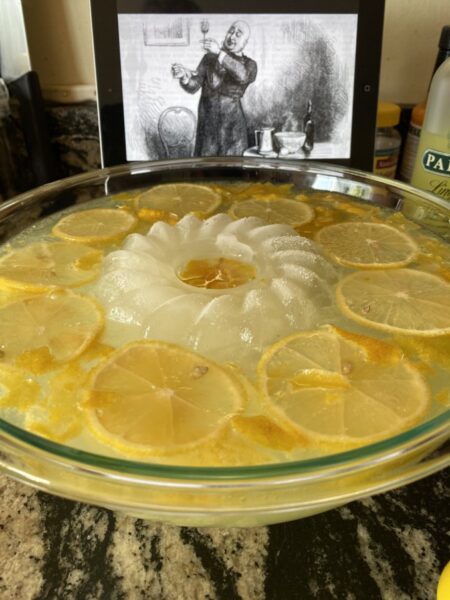
Cobbler’s Punch
- 3 lemons, large and as deeply yellow as you can find. (Your best bet will be to look in the seafood department of your supermarket.)
- ¾ cup white sugar
- 1 750-ml bottle of very cold gin
- ½ cup / 4 ounces limoncello
- 3 12-ounce bottles of extremely bubbly seltzer, chilled. Topo Chico would be excellent for this.
Peel the lemons and muddle the rind with the sugar at the bottom of a punch bowl.
Turn your back on the lemon sugar and find something else to do for three hours — maybe watch the first two Die Hard movies (see below).
Shortly before your guests arrive, squeeze the lemons. You’re aiming for ¾ cup of juice. Add it to the lemon sugar in your punch bowl, and stir to dissolve. You will be surprised at how much moisture the lemon peels have released already, preparing the sugar for its final disposition.
Add the other ingredients and stir.
Add an extremely large block of ice. If you have a small Bundt pan, make it in that. It will be a fancy ring of ice with a lot of surface area to chill the punch. Garnish with thin slices of lemon.
The key to this punch is the lemons. Dickens was right about that. It might be tempting to try rounding out the flavor with triple sec, or elderflower liqueur, or something that isn’t lemony. Don’t do it. The lemons know what they’re doing; don’t get in their way. Limoncello is the way to go on this.
The second key to this punch is extreme cold. Store your gin in the freezer for a day or so ahead of time. It won’t freeze, but it will get shockingly cold. Chill your seltzer. If it’s really cold outside on the night of your party, make this on the patio. Or balcony. Or fire escape.
Part 3:
Is Die Hard a Christmas Movie?
Yes. Yes, it is.
The Nakatini
- 2 ounces Szechuan peppercorn-infused gin (see below)
- 1½ ounces ginger syrup
- 1 ounce fresh-squeezed lemon juice
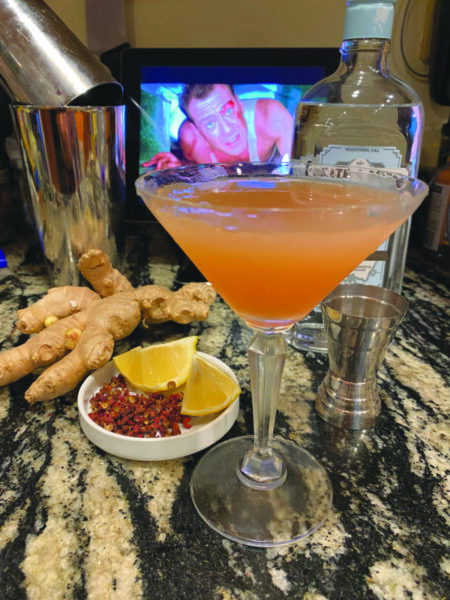
Combine all ingredients with ice in a cocktail shaker. Shake like a building that has just had a bomb go off on the roof, taking out a helicopter full of overconfident federal agents.
Strain carefully into a martini glass — carefully, as if the gin were an international terrorist with unknown motivations.
Drink it. You have two options here:
(a) Knock it back blithely, overconfident in your ability to handle factors well beyond your understanding. This might not end well for you, but fortune favors the bold. Sometimes.
(b) Sip it gingerly (get it?) like a wounded hero hobbling across the floor with feet full of broken glass.
Every now and then you run across somebody who has never seen Die Hard. If you ever managed to sit them down and force them to watch it, they would almost certainly start out skeptical:
Them: “Bruce Willis? Really? But he’s so—”
You: “Shhh. Be patient.”
After half an hour they will slip into a stunned silence.
Approximately an hour and a half, two explosions and 73 shootings later (I looked it up) they will be sitting, mouth agape, in a sort of a fugue state.
You: “So?”
Them: “Wow. I, uh, I had no idea. Um — wow.”
You: “Do you want to watch it again?”
Them: “Yes. No. Uh, my brain can’t — um —”
You: “Will you ever be the same, from this point forward?”
Them: “I really don’t think so.”
That’s what drinking a Nakatini is like. Szechuan peppercorns are delicious, spicy — not too hot — and a little citrusy. They go well with the aromatics in gin. Gin, in its turn, goes extremely well with lemon, which goes with the citrusness of the peppercorns. All of it marries well with ginger.
But Szechuan peppercorns — and this is the part that is just like watching Die Hard for the first time — have a numbing effect on your lips and tongue. Your mouth will feel exactly like it just watched a wounded cop swing through a window on the end of a fire hose.
Szechuan Pepper-Infused Gin
- 1 cup / 8 ounces / 237 ml. good-but-not-very-expensive gin
- 1 tablespoon Szechuan peppercorns
Combine the gin and Szechuan peppercorns in a small bottle. Forcing the peppercorns through the neck of a funnel with a chopstick will break them up just enough.
Cap the bottle and shake it. Let the mixture infuse for 24 hours, shaking it periodically.
Strain and rebottle.
Part 4:
A Christmas Drink for Guys and Dolls
Before Tom and Jerry were a cartoon, they were a Very Serious Drink.
As described by Damon Runyan:
This hot Tom and Jerry is an old-time drink that is once used by one and all in this country to celebrate Christmas with, and in fact it is once so popular that many people think Christmas is invented only to furnish an excuse for hot Tom and Jerry, although of course this is by no means true. … Now of course Good Time Charley and I are not using rum in the Tom and Jerry we are making, as we do not wish to do anything illegal. What we are using is rye whisky that Good Time Charley gets on a doctor’s prescription from a drug store, as we are personally drinking this hot Tom and Jerry and naturally we are not foolish enough to use any of Good Time Charley’s own rye in it. The prescription for the rye whisky comes from old Doc Moggs, who prescribes it for Good Time Charley’s rheumatism in case Charley happens to get any rheumatism, as Doc Moggs says there is nothing better for rheumatism than rye whisky, especially if it is made up in a hot Tom and Jerry.
— Damon Runyon, Dancing Dan’s Christmas, Damon Runyon Omnibus
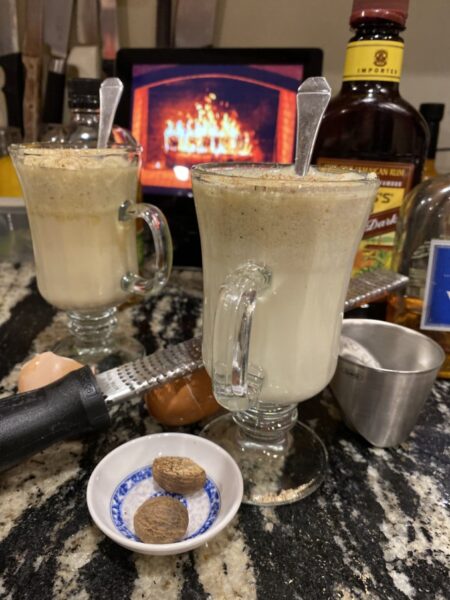
The good news about a Tom and Jerry is that it doesn’t require any preparations that need to be made days in advance. Do not be overconfident, however — making a credible T&J requires a cool eye and steady nerves.
Tom and Jerry Batter
- 3 eggs, separated
- ¼ cup powdered sugar
- ¼ teaspoon freshly ground allspice
- ¼ teaspoon cinnamon
- ¼ teaspoon freshly ground black pepper
Beat egg whites to stiff peaks.
Separately, beat the egg yolks, powdered sugar and spices until they lighten in color. (The mixture will look like whole-grain mustard, but not as angry.)
Carefully fold the egg whites into the yolk mixture, being careful not to deflate them. This is a lot like making a soufflé, if that means anything to you. Beat about 1/4 of the egg whites into the mixture, just to lighten it up a bit. Then add the rest of the whites, 1/3 at a time, folding them in gently, until everything is evenly mixed but still light and fluffy. You’ll have 3 or 4 cups of the final mixture when you are done.
Set this mixture aside. It is your “batter.”
Tom and Jerry
- 2 Tablespoons / ¼ cup “batter” mixture
- 2 Tablespoons / ¼ cup “batter” mixture
- ¾ ounces brandy or 2 ounces rye whiskey
- 1½ ounces dark rum — Myers, in this case
Hot milk
Add “batter” and alcohol to a mug. The 1935 edition of the Mr. Boston Bartender’s Guide is explicit about the importance of making a Tom and Jerry in a heated mug, so fill yours with boiling water for a few minutes before mixing the actual drink. Remember to pour the water out before adding the other ingredients. That may seem obvious, but might become less so after two or three Tom and Jerrys.
Top with hot milk. (How hot? I like mine to be around 175º F / 80º C.)
Stir to combine.
Garnish with fresh-grated nutmeg. Seriously, if you’ve never grated your own nutmeg, try it. Just smell a little of it in the palm of your hand. It will be a revelation.
I tried this recipe both ways — with rum and with rye. I’m generally a rum guy, and even Damon Runyon’s character admits up front that a Tom and Jerry is best with rum. On the other hand, I’d feel foolish to go to all this trouble and end up with rheumatism.
The rye recipe is completely delicious. The spiciness of the rye plays really well with the black pepper. There is a whiskeyness to it that feels extremely Runyonesque.
Tom and Jerry 1 – rheumatism 0.
The rum recipe knocked me back on my heels. I have to go with the 1930s hoodlum logic on this. A rum Tom and Jerry — or three — would make for a truly magical Christmas. The deep, sweet muskiness of the rum adds a layer of decadence to the whole affair that really could convince you to break into a showgirl’s apartment dressed as Santa Claus and leave her stolen diamonds. (See Damon Runyan, above.)
(If the idea of using a raw egg in a cocktail is a little too 1930s hoodlumish for you, some supermarkets carry pasteurized eggs. Alternatively, you can pasteurize your own by heating them in a water bath at 135 degrees for two hours. If you have a sous vide apparatus, this is an excellent use for it. If you don’t, you know what to ask for this Christmas.)
Part 5:
Giving the Joint Some Atmosphere
Nick: “Hey, look mister, we serve hard drinks in here for men who want to get drunk fast. And we don’t need any characters around to give the joint atmosphere. Is that clear? Or do I have to slip you my left for a convincer?”
Nick(Sheldon Leonard)– It’s a Wonderful Life, 1946
I was a senior in college before I saw It’s a Wonderful Life. In my defense, this was in the mid-’80s, before the movie was on TV, demand and video quite so ubiquitously.
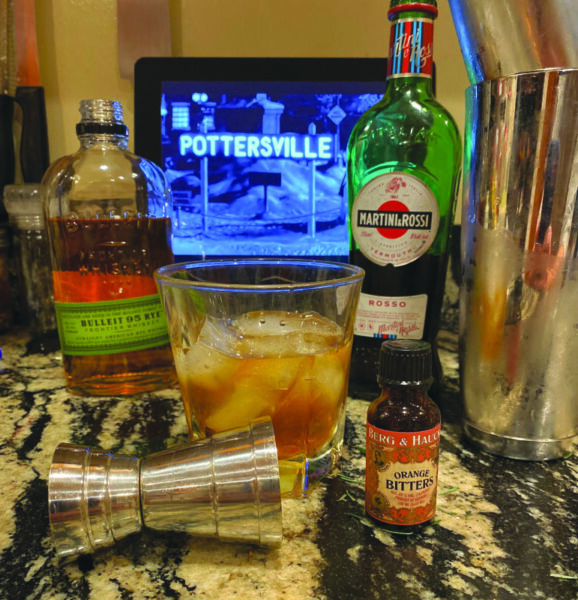
We were screening it in the school’s dining hall. The music swelled, Zuzu said her line about angels getting their wings, and the movie ended. Someone turned on the lights, and the other students all got up, put on their coats and left, leaving me and a buddy of mine sitting there, crying like French soccer players.
I hadn’t even realized that JP was at the movie. Apparently, he hadn’t ever seen the movie before either, because he got up and walked across the room to me, tears streaming down his face.
“Are you OK?” he asked me.
I nodded between sobs.
“It’s just that he had … such … a … hard … life!”
JP understood.
“But … it … was ….” At this point, we both broke down completely.
“…A WONDERFUL life!” he wailed. We hugged.
To this day I can get through the entire movie pretty well until that last scene, when the whole town shows up to give Jimmy Stewart money, and Martini, the bar owner, shouts, “I broke open the juke-a-box!”
**Sniff**
Dang it.
Pottersville Special
- 1½ ounces rye
- ¾ ounce sweet vermouth
- ⅛ teaspoon orange bitters
Shake over ice.
Pour into a rocks glass.
Drink, garnished with sentimental tears.
This is delicious, with a hard edge. It makes you realize that you may have bought that rye to make the Damon Runyan drink but you are starting to really like it. It has an emotional whiskeyness to it, but sweetened and tempered by the vermouth and bitters. This is what you’d drink if the bank examiner were coming to serve a warrant for your arrest, but if you weren’t quite ready for prison yet.
Part 6:
Big Man on Krampus
“The Feast of St. Nicholas is celebrated in parts of Europe on 6 December. On the preceding evening of 5 December, Krampus Night or Krampusnacht, the wicked hairy devil appears on the streets. Sometimes accompanying St. Nicholas and sometimes on his own, Krampus visits homes and businesses. … Unlike North American versions of Santa Claus, in these celebrations Saint Nicholas concerns himself only with the good children, while Krampus is responsible for the bad. Nicholas dispenses gifts, while Krampus supplies coal and the Ruten bundles (birch rods to beat the children with). It is customary to offer a Krampus schnapps, a strong distilled fruit brandy.”
— Wikipedia page on Krampus
Dieter Krampus snuck a look at his watch. He had a couple of minutes before he and The Boss had to be at the next house.

He set down his sack of birch switches and stood up straight, stretching the kinks out of his back. All in all this was a pretty good gig, but Dieter had to admit it was harder on his body than it used to be. He leaned his head from side to side, stretching out his neck, and was rewarded with a couple more popping sounds — a task that was aided significantly by the weight of the enormous horns growing out of the top of his head. He’d be happy to shed them in a couple of days. Yes, they itched like the devil as they grew back in, but he couldn’t imagine hauling that weight around all year.
“Herr Krampus?”
It didn’t matter how long they had worked together, The Boss was always formal.
Dieter was getting tired. It had been a long night. He let out a grunt as he bent over and picked up his sack. He must have groaned a little louder than he intended, because the saint called out softly to him again, this time with a little encouragement.
“Time for some schnapps, don’t you think, Herr Krampus?”
Say what you will about The Boss, nobody understood the concept of Carrot and Stick better than he did.
“On my way, Mein Herr.”
Switches and Coal
The legends and traditions are pretty clear: The traditional drink for a Krampus is a straight shot of schnapps. That’s great if you’re putting in a hard night of terrifying children, but what about when your shift is over and you get a chance to put your hooves up? You’ll want something refreshing but with some authority.
This is a take on a classic drink called a Black Satin, but boilermaker-y:
- 3 ounces very dark beer — stout or porter
- 3 ounces brut Champagne
- 2 ounces of the darkest rum you can get your hands on — I like Cruzan Black Strap
Gently pour the very dark beer into a tall glass.
Float the Champagne on top of it. Pour it over the back of a spoon. It will not make visibly separate layers, but it makes a difference.
Pour a shot of very dark rum, then drop it into the mixture.
Drink, while complaining to your husband about your day.
We all understand, intellectually, that grapes are a fruit, but it is still shocking how fruity and chocolatey this drink is. It is utterly delicious and just what you want to drink if you’ve had a hard day with the kids. It goes down dangerously smoothly.
Part 7:
The Ferociousness of a Puerto Rican Grandmother
Over the past several years, as I have researched my family tree, the most joy has come — hands down — from a branch of my father’s family from the hill country in Kentucky.
Case in point: my Great Uncle Wirt, who was ridden out of town on a rail and ended up in upstate New York, and was arrested for fishing in a state park.
With dynamite.
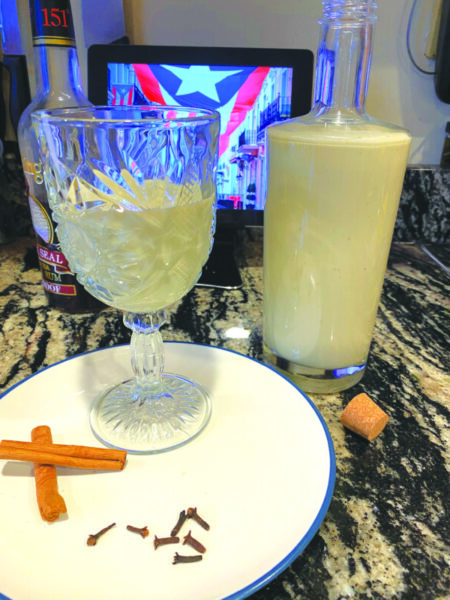
I mention this to help illustrate an (admittedly shaky) analogy between Kentucky and Puerto Rico. Both are well-known for their fine, sophisticated liquor — upscale bourbon near Churchill Downs, and golden añejo rum on the beaches and resorts of Puerto Rico. But as you move up into the hills in either place, both the people and their alcohol become somewhat alarming.
It would be rude to turn down your cousin Cletus’ offer of a taste of his moonshine — acknowledging all the while that you would be seriously rolling the dice to drink it. In the same vein, there are Puerto Rican grandfathers who make a sugarcane liquor called pitoro that can strip the chrome off a trailer hitch.
The traditional holiday drink in Puerto Rico in December is a rich, creamy concoction called coquito. Some people describe it as “Puerto Rican eggnog,” but that’s misleading; there are no eggs in it. There is, however, an alarming amount of pitoro.
Ask any Puerto Rican about coquito and they will get misty-eyed remembering their mother or grandmother’s recipe — much like a Southerner’s relationship with biscuits — but they will almost always finish with a statement like, “But if you go up into the hills, their coquito is really scary!”
A friend of mine tells me that each family has its own recipe for coquito. “At each house it tastes different,” she says. Every mother or grandmother has two secret ingredients that they use to make their version. “Some of my friends’ mothers added ice cream to make their coquito creamier,” my friend Myrta says. “My mother,” she adds, pausing dramatically, then continuing almost in a whisper, “uses pistachio ice cream.”
The second secret ingredient is almost always extra alcohol.
Let’s be really clear here: This will not be as good as Myrta’s mother’s coquito. It will be really, really good, but for the real stuff you’ll have to go to Puerto Rico.
Coquito
- 1 15-ounce can cream of coconut (the presweetened, incredibly artificial kind you would use for dorm-room piña coladas)
- 1 14-ounce can condensed milk
- 1 14-ounce can coconut milk (Warning: If you even think of using any low-fat ingredients in coquito, you risk angering vengeful Caribbean spirits. I wouldn’t risk it.)
- 1 cup / 8 ounces overproof rum (I like Gosling’s Black Seal 151.)
- ½ cup water
- 1 cup pistachio ice cream
- 1 teaspoon vanilla
- 2 cinnamon sticks
- 2 whole cloves
- 1 pinch ground cinnamon
- 1 pinch freshly grated nutmeg
Add all ingredients except the cinnamon sticks and cloves to a blender. Blend on low speed for 1 to 2 minutes.
Strain into one large, or two large-ish, jars. Add the whole spices, seal and shake.
Refrigerate for at least overnight, or better yet, 2 to 3 days.
Your finished coquito will be pretty thick, so you will probably want to thin it with a little water, but that said, if you want to tackle it full-octane, more power to you.
Coquito is very everything — very sweet, very coconutty and very boozy. This is not for someone with mixed feelings about the holidays. It is for fully embracing the season and singing loudly— louder with each glass of coquito. I’m not saying you will necessarily end up waking your wife at 2 a.m. singing “Oh-hoe tie-eye-dings of CUH-HUM-FORT AND JOY!”, wavering on the lowest note you can force out of your chest.
But you might.
Part 8:
“Yeah, But What if I’m a Teetotalling, Gluten-Free Vegan?”
I think the best inspiration for this challenge is Hermey the Elf, from the Rankin-Bass Christmas classic Rudolph the Red-Nosed Reindeer. If you don’t remember Hermey, he is the tacitly closeted elf who, unhappily working on Santa’s toy assembly line, yearns to be a dentist. After being mocked and punished for not being as butch as the rest of the elves (Yes, I know. What can I say? It was the ’60s.), he runs away to seek his fortune, singing one of the greatest “I Want” songs in movie history:

Hermey: “Why am I such a misfit? I am not just a nitwit. You can’t fire me, I quit. Seems I don’t fit in.”
Like every character in the Rudolph story, he is eventually provisionally accepted once he can prove himself useful to a judgmental society.
You could take several lessons from Hermey’s adventures:
Work hard and be loyal to your friends, and the Universe will reward you.
Inspire respect by ripping the teeth out of your enemies with pliers.
Don’t wait for the world to accommodate you; create your own destiny — or, in this case, your own festive holiday beverage.
Let’s focus on the third one, shall we?
Caffeine for Hermey
- 2 cups almond milk
- ⅓ cup white sugar
- 1½ cups whole coffee beans
- pinch of salt
- 1 cinnamon stick
- 1 cup non-dairy half & half
- 1 tablespoon vanilla
Combine the almond milk, sugar, salt, coffee beans and cinnamon stick in a small saucepan. Heat to just below a simmer, approximately 174 degrees, stirring occasionally. The sugar should dissolve completely.
Remove from heat, cover, and allow to steep for two hours.
Strain the mixture to remove the coffee beans and the cinnamon stick. Wash your hands and squeeze the coffee beans to wring every bit of flavor from them.
Add the non-dairy half & half and the vanilla. Stir to combine.
Chill for 2 to 3 hours.
Drink with a proud heart and kind thoughts for Hermey.
“This is really good and all, but isn’t it just iced coffee?”
I can’t help noticing that you’re on your third glass of it.
“Well, that’s only because it’s so creamy. It tastes … friendly.”
I wouldn’t know. There isn’t any left.
“Uh, yeah … Merry Christmas.”
You too, Petal.
Featured Photo: Courtesy photo.

